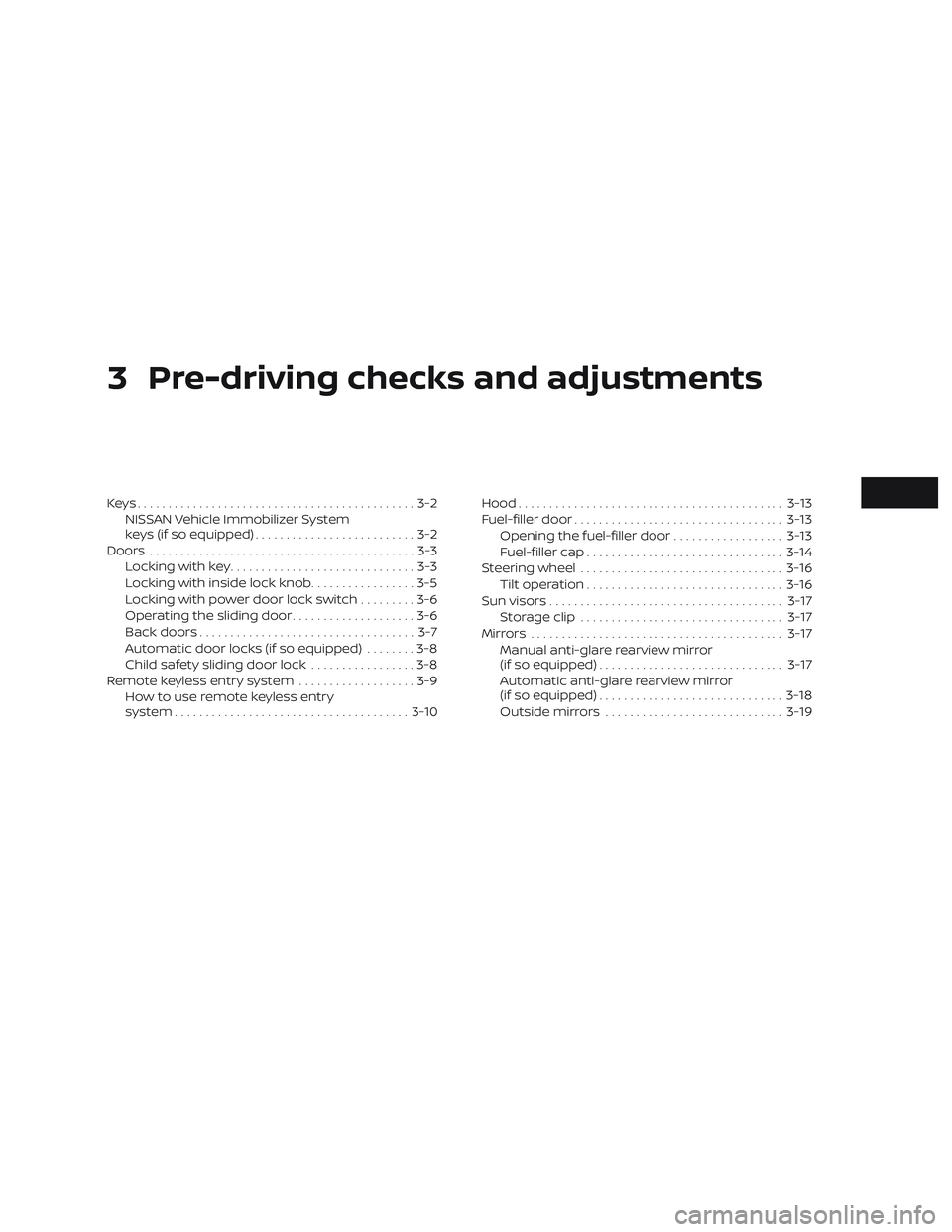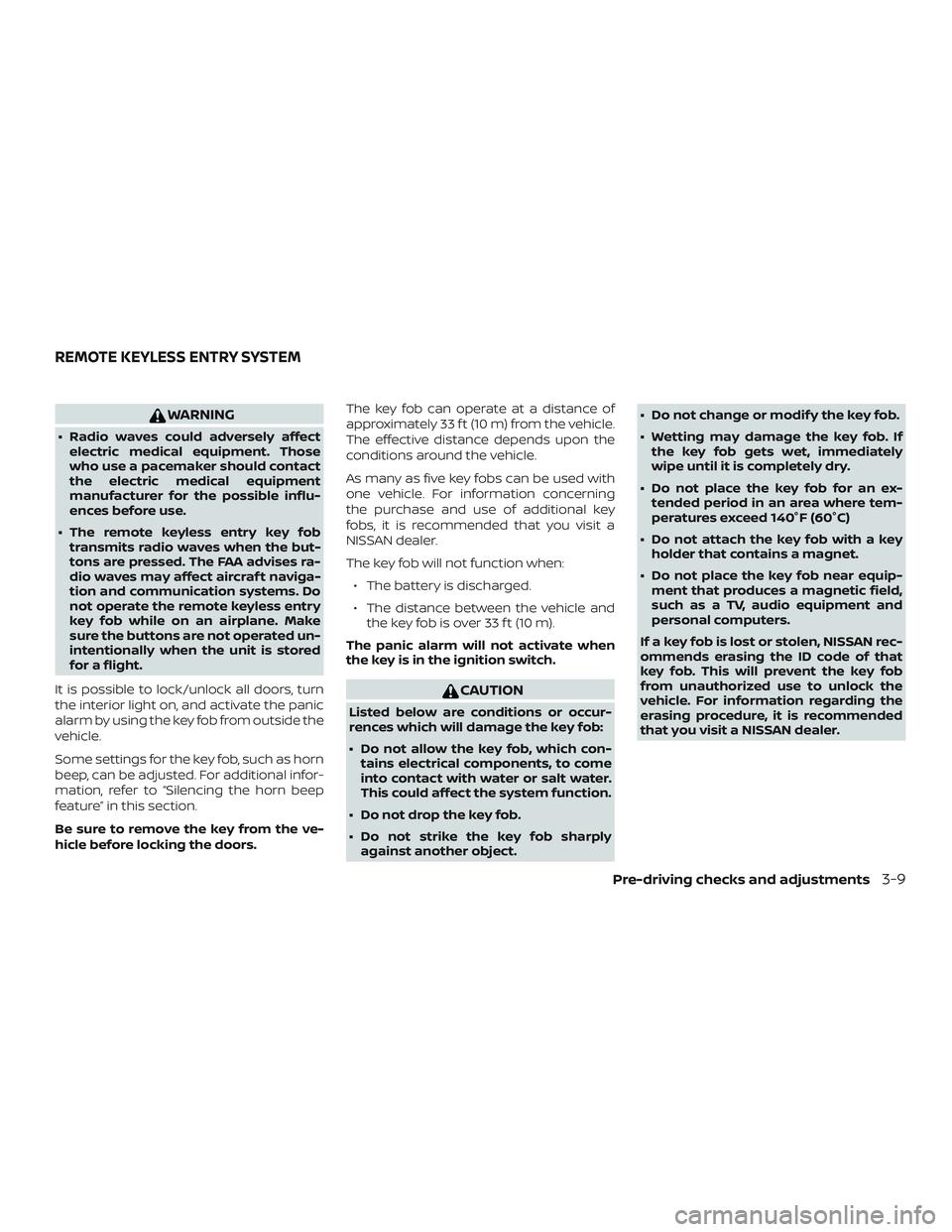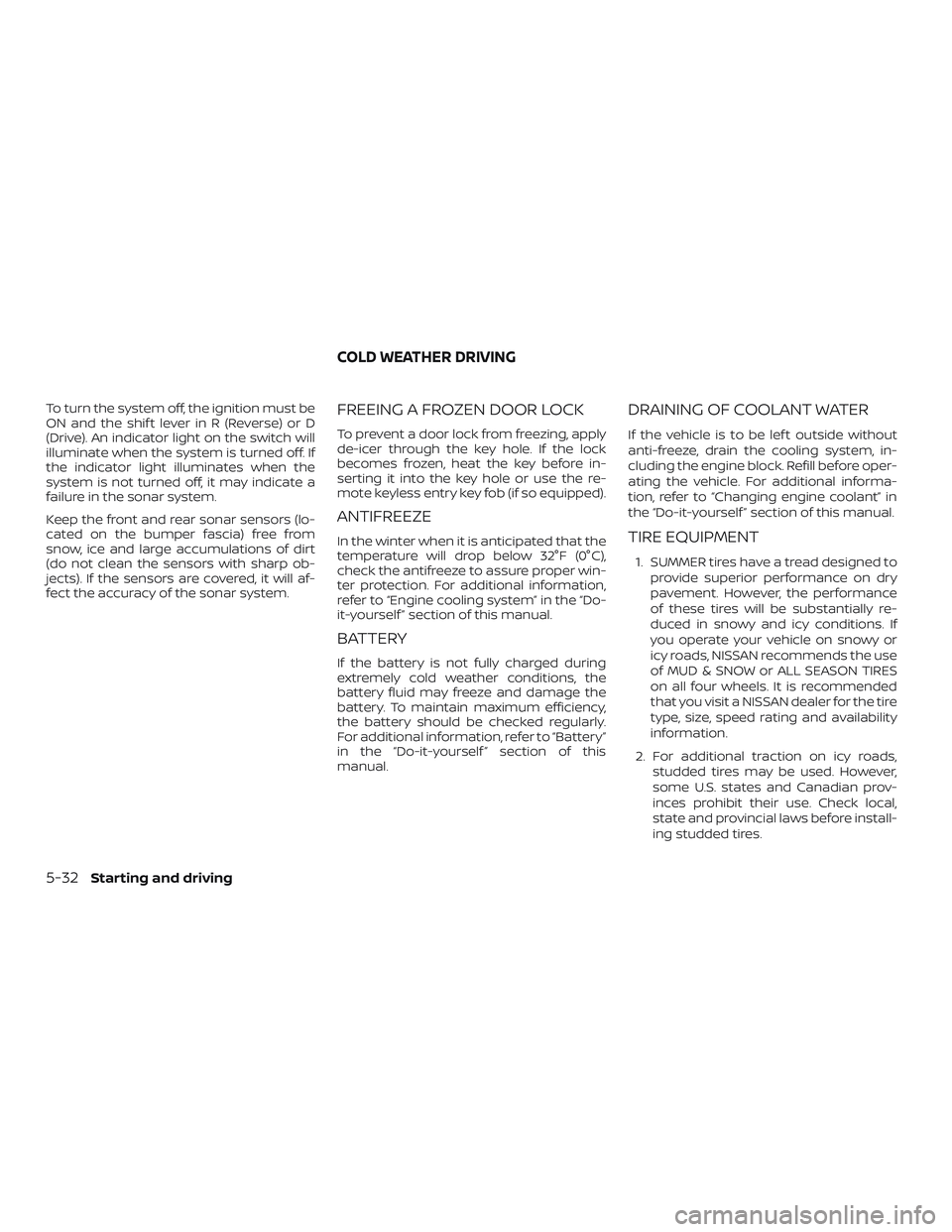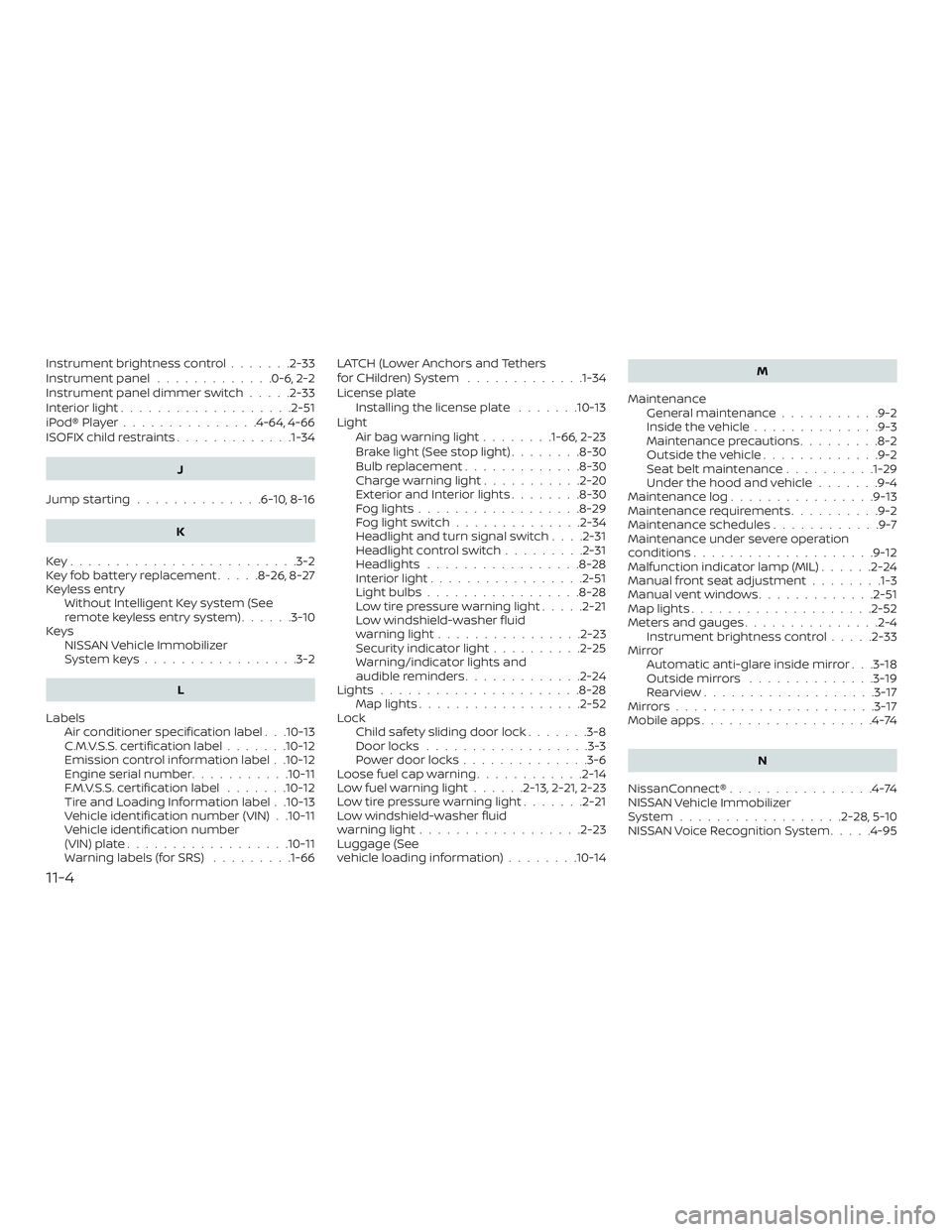2018 NISSAN NV PASSENGER VAN keyless
[x] Cancel search: keylessPage 144 of 426

3 Pre-driving checks and adjustments
Keys.............................................3-2NISSAN Vehicle Immobilizer System
keys (if so equipped) ..........................3-2
Doors ...........................................3-3
Locking with key ..............................3-3
Locking with inside lock knob .................3-5
Locking with power door lock switch .........3-6
Operating the sliding door ....................3-6
Back doors ................................... 3-7
Automatic door locks (if so equipped) ........3-8
Child safety sliding door lock .................3-8
Remote keyless entry system ...................3-9
How to use remote keyless entry
system ...................................... 3-10Hood
........................................... 3-13
Fuel-filler door .................................. 3-13
Opening the fuel-filler door ..................3-13
Fuel-filler cap ................................ 3-14
Steering wheel ................................. 3-16
Tilt operation ................................ 3-16
Sun visors ...................................... 3-17
Storage clip ................................. 3-17
Mirrors ......................................... 3-17
Manual anti-glare rearview mirror
(if so equipped) .............................. 3-17
Automatic anti-glare rearview mirror
(if so equipped) .............................. 3-18
Outside mirrors ............................. 3-19
Page 152 of 426

WARNING
∙ Radio waves could adversely affectelectric medical equipment. Those
who use a pacemaker should contact
the electric medical equipment
manufacturer for the possible influ-
ences before use.
∙ The remote keyless entry key fob transmits radio waves when the but-
tons are pressed. The FAA advises ra-
dio waves may affect aircraf t naviga-
tion and communication systems. Do
not operate the remote keyless entry
key fob while on an airplane. Make
sure the buttons are not operated un-
intentionally when the unit is stored
for a flight.
It is possible to lock/unlock all doors, turn
the interior light on, and activate the panic
alarm by using the key fob from outside the
vehicle.
Some settings for the key fob, such as horn
beep, can be adjusted. For additional infor-
mation, refer to “Silencing the horn beep
feature” in this section.
Be sure to remove the key from the ve-
hicle before locking the doors. The key fob can operate at a distance of
approximately 33 f t (10 m) from the vehicle.
The effective distance depends upon the
conditions around the vehicle.
As many as five key fobs can be used with
one vehicle. For information concerning
the purchase and use of additional key
fobs, it is recommended that you visit a
NISSAN dealer.
The key fob will not function when:
∙ The battery is discharged.
∙ The distance between the vehicle and the key fob is over 33 f t (10 m).
The panic alarm will not activate when
the key is in the ignition switch.
CAUTION
Listed below are conditions or occur-
rences which will damage the key fob:
∙ Do not allow the key fob, which con- tains electrical components, to come
into contact with water or salt water.
This could affect the system function.
∙ Do not drop the key fob.
∙ Do not strike the key fob sharply against another object. ∙ Do not change or modif y the key fob.
∙ Wetting may damage the key fob. If
the key fob gets wet, immediately
wipe until it is completely dry.
∙ Do not place the key fob for an ex- tended period in an area where tem-
peratures exceed 140°F (60°C)
∙ Do not attach the key fob with a key holder that contains a magnet.
∙ Do not place the key fob near equip- ment that produces a magnetic field,
such as a TV, audio equipment and
personal computers.
If a key fob is lost or stolen, NISSAN rec-
ommends erasing the ID code of that
key fob. This will prevent the key fob
from unauthorized use to unlock the
vehicle. For information regarding the
erasing procedure, it is recommended
that you visit a NISSAN dealer.
REMOTE KEYLESS ENTRY SYSTEM
Pre-driving checks and adjustments3-9
Page 153 of 426

HOW TO USE REMOTE KEYLESS
ENTRY SYSTEM
Locking doors
1. Close all windows.
2. Remove the key from the ignitionswitch.
3. Close the hood and all doors.
4. Press the
button on the key fob.
All the doors lock. The hazard warning
lights flash twice and the horn beeps
once to indicate all doors are locked. ∙ When the
button is pressed
with all doors locked, the hazard warn-
ing lights flash twice and the horn
beeps once as a reminder that the
doors are already locked.
∙ If a door is open and you press the
button, the doors will lock
but the horn will not beep and the haz-
ard warning lights will not flash.
The horn may or may not beep. For addi-
tional information, refer to “Silencing the
horn beep feature” in this section.
Unlocking doors
Press thebutton on the key fob once.
∙ Only the driver’s door unlocks.
∙ The hazard warning lights flash once if all doors are completely closed with the
ignition switch in any position except
the ON position.
∙ The interior lights turn on and the light timer activates for a period of time
when the interior light switch is in the
center position with the ignition switch
in any position except the ON position.
LPD0209LPD0210
3-10Pre-driving checks and adjustments
Page 295 of 426

To turn the system off, the ignition must be
ON and the shif t lever in R (Reverse) or D
(Drive). An indicator light on the switch will
illuminate when the system is turned off. If
the indicator light illuminates when the
system is not turned off, it may indicate a
failure in the sonar system.
Keep the front and rear sonar sensors (lo-
cated on the bumper fascia) free from
snow, ice and large accumulations of dirt
(do not clean the sensors with sharp ob-
jects). If the sensors are covered, it will af-
fect the accuracy of the sonar system.FREEING A FROZEN DOOR LOCK
To prevent a door lock from freezing, apply
de-icer through the key hole. If the lock
becomes frozen, heat the key before in-
serting it into the key hole or use the re-
mote keyless entry key fob (if so equipped).
ANTIFREEZE
In the winter when it is anticipated that the
temperature will drop below 32°F (0°C),
check the antifreeze to assure proper win-
ter protection. For additional information,
refer to “Engine cooling system” in the “Do-
it-yourself ” section of this manual.
BATTERY
If the battery is not fully charged during
extremely cold weather conditions, the
battery fluid may freeze and damage the
battery. To maintain maximum efficiency,
the battery should be checked regularly.
For additional information, refer to “Battery”
in the “Do-it-yourself ” section of this
manual.
DRAINING OF COOLANT WATER
If the vehicle is to be lef t outside without
anti-freeze, drain the cooling system, in-
cluding the engine block. Refill before oper-
ating the vehicle. For additional informa-
tion, refer to “Changing engine coolant” in
the “Do-it-yourself ” section of this manual.
TIRE EQUIPMENT
1. SUMMER tires have a tread designed toprovide superior performance on dry
pavement. However, the performance
of these tires will be substantially re-
duced in snowy and icy conditions. If
you operate your vehicle on snowy or
icy roads, NISSAN recommends the use
of MUD & SNOW or ALL SEASON TIRES
on all four wheels. It is recommended
that you visit a NISSAN dealer for the tire
type, size, speed rating and availability
information.
2. For additional traction on icy roads, studded tires may be used. However,
some U.S. states and Canadian prov-
inces prohibit their use. Check local,
state and provincial laws before install-
ing studded tires.
COLD WEATHER DRIVING
5-32Starting and driving
Page 421 of 426

Instrument brightness control.......2-33
Instrument panel .............0-6,2-2
Instrument panel dimmer switch .....2-33
Interiorlight...................2-51
iPod®Player...............4-64,4-66
ISOFIX child restraints .............1-34
J
Jumpstarting..............6-10,8-16
K
Key.........................3-2
Key fob battery replacement .....8-26,8-27
Keyless entry Without Intelligent Key system (See
remote keyless entry system) ......3-10
Keys NISSAN Vehicle Immobilizer
Systemkeys.................3-2
L
Labels Air conditioner specification label . . .10-13
C.M.V.S.S. certification label .......10-12
Emission control information label . .10-12
Engine serial number ...........10-11
F.M.V.S.S. certification label .......10-12
Tire and Loading Information label . .10-13
Vehicle identification number (VIN) . .10-11
Vehicle identification number
(VIN)plate..................10-11
Warning labels (for SRS) .........1-66LATCH (Lower Anchors and Tethers
forCHildren)System ............
.1-34
License plate Installing the license plate .......10-13
Light Airbagwarninglight........1-66, 2-23
Brakelight(Seestoplight)........8-30
Bulb replacement .............8-30
Charge warning light ...........2-20
ExteriorandInteriorlights........8-30
Foglights..................8-29
Foglightswitch..............2-34
Headlight and turn signal switch ....2-31
Headlightcontrolswitch.........2-31
Headlights.................8-28
Interiorlight.................2-51
Lightbulbs.................8-28
Low tire pressure warning light .....2-21
Low windshield-washer fluid
warninglight................2-23
Security indicator light ..........2-25
Warning/indicator lights and
audible reminders .............2-24
Lights......................8-28 Maplights..................2-52
Lock Child safety sliding door lock .......3-8
Door locks ..................3-3
Power door locks ..............3-6
Loose fuel cap warning ............2-14
Lowfuelwarninglight......2-13,2-21,2-23
Low tire pressure warning light .......2-21
Low windshield-washer fluid
warninglight..................2-23
Luggage (See
vehicle loading information) ........10-14 M
Maintenance General maintenance ...........9-2
Insidethevehicle..............9-3
Maintenance precautions .........8-2
Outsidethevehicle.............9-2
Seat belt maintenance ..........1-29
Under the hood and vehicle .......9-4
Maintenance log ................9-13
Maintenance requirements ..........9-2
Maintenance schedules ............9-7
Maintenance under severe operation
conditions....................9-12
Malfunctionindicatorlamp(MIL)......2-24
Manual front seat adjustment ........1-3
Manual vent windows .............2-51
Maplights....................2-52
Meters and gauges ...............2-4
Instrument brightness control .....2-33
Mirror Automatic anti-glare inside mirror . . .3-18
Outsidemirrors ..............3-19
Rearview...................3-17
Mirrors......................3-17
Mobile apps ...................4-74
N
NissanConnect® ................4-74
NISS
AN Vehicle Immobilizer
System..................2-28,5-10
NISSAN Voice Recognition System .....4-95
11-4
Page 422 of 426

O
Octane rating (See fuel octane rating) . .10-6
Odometer ....................2-5
Oil Capacities and recommended
fuel/lubricants...............10-2
Changing engine oil ............8-9
Changing engine oil filter .........8-11
Checking engine oil level .........8-8
Engine oil ...................8-8
Engine oil and oil filter
recommendation .............10-7
Engine oil viscosity .............10-7
One shot call ..............4-78,4-89
Outsidemirrors ................3-19
Overhead sunglasses holder ........2-47
Overheat Ifyourvehicleoverheats.........6-12
Owner's manual order form ........10-35
Owner's manual/service manual
orderinformation ..............10-35
P
Parking Parking brake operation .........5-18
Parking/parkingonhills.........5-23
Parkingbrake..................5-18
Phone, Bluetooth® hands-free system . .4-75
Power Power door locks ..............3-6
Poweroutlet.............2-39,2-40
Powersteeringfluid............8-13
Power steering system ..........5-23 Powerwindows..............2-50
Powerinverterswitch ............2-36
Poweroutlet...............2-39,2-40
Powersteering.................5-23
Powersteeringfluid..............8-13
Precautions Maintenance precautions .........8-2
Precautions on booster
seats............1-32, 1-40, 1-46, 1-52
Precautions on child
restraints.........1-32, 1-40, 1-46, 1-52
Precautions on seat belt usage .....1-21
Precautions on supplemental
restraint system ..............1-55
Precautions when starting
and driving ...............5-2,5-3
Programmable features ............4-7
Push starting ..................6-12
R
Radio Car phone or CB radio ..........4-74
FM/AM radio with
compact disc (CD) player ........4-42
FM/AM/SAT radio with
compact disc (CD) player .....4-47,4-53
Steering wheel audio control
switch....................4-72
Readiness for inspection
maintenance (I/M) test ...........10-34
Rear seat air conditioner ...........4-31
Rear sonar system ..............5-29
Rear sonar system off switch ........2-37
Rearviewmirror ............... .3-17RearViewMonitor ...............4-11
Rear window and outside mirror
defrosterswitch................2-30
Recommended Fluids
............10-2
Recorders EventData.................10-34
Refrigerant recommendation ........10-8
Registering a vehicle in another
country .....................10-11
Remote keyless entry system .....3-9,3-10
Reporting safety defects (US only) . . . .10-33
Reset TPMS ................2-13,8-41
S
Safety Child safety sliding door lock .......3-8
Childseatbelts .....1-32, 1-40, 1-46, 1-52
Reporting safety defects (US only) . .10-33
Seat adjustment Front manual seat adjustment ......1-3
F
ront power seat adjustment ......1-4
Seat belt Childsafety................ .1-29
Infants and small children ........1-30
InjuredPerson.............. .1-24
Largerchildren.............. .1-31
Precautionsonseatbeltusage.....1-21
Pregnant women .............1-24
Seat belt extenders ............1-28
Seat belt maintenance ..........1-29
Seatbelts................1-21, 7-5
Shoulder belt height adjustment . . . .1-28
Three-pointtypewithretractor.....1-25
Seat belt extenders ..............1-28
11-5